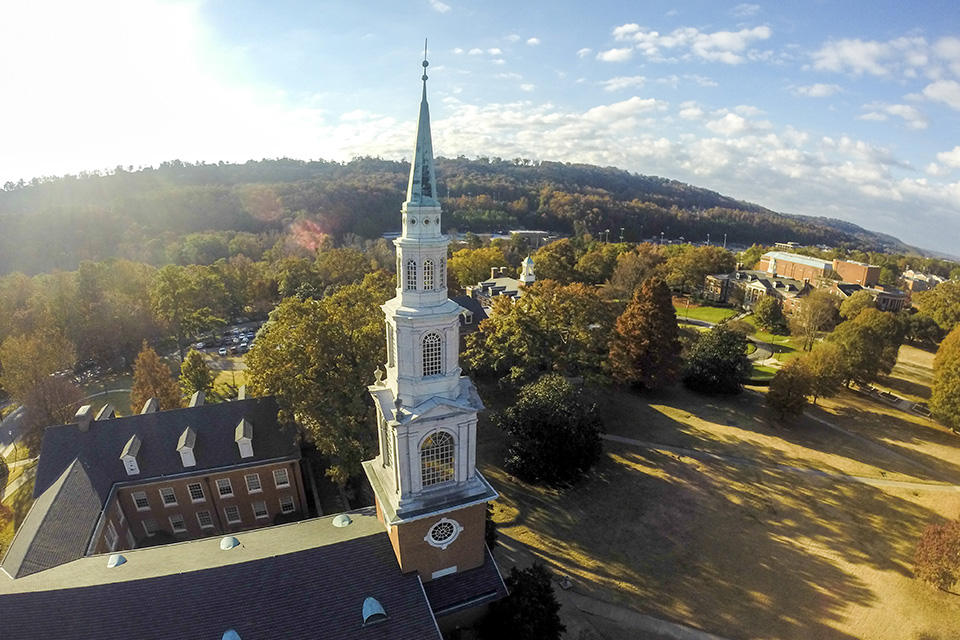
Samford University has high aspirations for its future, reflected in a new strategic plan recently approved by the university’s board of trustees. Implementation of the multiyear plan is underway, even as details are being finalized.
The plan has four main focus areas: emphasize student success, enhance our community, extend our reach and ensure financial strength. Each focus area has four main goals, and there are about 70 objectives being developed to guide and measure progress. The objectives will be reviewed and modified annually.
The plan was developed over the last 12 months under the direction of President Andrew Westmoreland and Chief Strategy Officer Colin Coyne. A 35-member planning committee representing all aspects of the university developed the document that was unanimously approved by trustees at their September meeting.
“The confidence that the board of trustees has in the university has never been stronger, and this new strategic plan gives the university a foundation on which to confidently build for an even better future,” said board chair William J. Stevens. “The collaborative teamwork across the Samford community to develop and implement this plan is a testimony to the shared commitment to Samford’s mission.”
The plan reflects responses to a survey of university constituents conducted earlier in 2014. Support for the university is overwhelmingly positive, based on the 2,750 survey responses from all constituent groups, according to Coyne. The plan builds on that confidence.
“Samford has more of what the world and our students need—what our parents want—than ever before,” Coyne said. “We do not have to change who we are. We dare to place expectations on our students, and we attract students who dare to place expectations on themselves.”
Those high expectations can translate into long-term success for the university and its graduates. “Samford’s willingness to define expectations is why our graduates succeed when they leave,” he added.
Emphasize Student Success
Goals in this focus area include recruiting faculty and staff “committed to exceptional standards of learning” and “extraordinary goals” for retention, graduation and placement.
Steven Epley, who served on the planning committee as Faculty Senate chair, noted that teaching and learning are top priorities in the new plan. Epley is associate professor of English.
“I am very pleased that the top priority for ensuring student success summons us to preserve and continuously improve our already outstanding teaching and learning environment,” Epley said. “We likewise strongly support the second priority, which undergirds the first in many ways by committing us to maintain our ‘exceptional standards for learning’ through nurturing and recruiting high-quality faculty and staff.”
Enhance Our Community
“Offering the love of Christ to all people” is the first goal in this focus area.
“This captures so many of our initiatives and the tone that has been set on campus for the past few years,” Coyne said. “We are dedicated to our Christian mission, and Samford’s plan covers at an even higher plane the discussion that many universities are having about cultural and ethnic diversity.”
Another goal would position Samford as a “convening place for people and ideas,” he noted. “This is not just about being good at what we do, but helping to shape the educational environment around us. Samford has the capacity to influence educational policy, not just to react to what others say and do. We need to influence rather than be influenced.”
Extend Our Reach
Samford is a university with national reach and global aspirations, Coyne said. That includes looking beyond the traditional campus context while providing global perspectives for students and faculty and within the curriculum.
“The new plan provides so many new opportunities to enhance Samford’s cultural diversity on many levels,” said Denise Gregory, Samford’s director of diversity and intercultural initiatives. “We want Samford students, alumni and employees to be engaged multiculturally, not just on campus, but in understanding the global society in which we live and work.”
Online education is another potential objective. Institutions that do not plan effectively for online education are likely to fail, Coyne noted, and it is “important to maintain the quality of education and Samford’s academic reputation with any new program.”
The plan calls for developing an “appropriate and robust” online platform that helps students build a personal relationship with the university and faculty but also builds an online community in Samford’s Christian context.
“What makes Samford special is that we have that distinction, and we’re committed to building that with our online programs,” Coyne emphasized.
Ensure Financial Strength
Being good stewards of the university’s resources is both important and prudent, while providing guidelines for enrollment growth, long-term capital needs and long-term financial stability, Coyne said.
He noted that retention goals under student success also tie to financial goals within the plan, including an ambitious goal of 98 percent freshman-to-sophomore retention by 2020.
“Increasing our retention rate will positively impact our financial foundation,” he said. “We have an obligation once we admit a student to make sure that student graduates from Samford.”
Continue Forward
Coyne and Westmoreland both emphasized that the plan is intended as a guide for the future. It gives flexibility while providing direction for planning and implementation.
“We will rank goals and objectives by priority,” Coyne explained. “By having specific deadlines, costs and quantifiable expectations, the plan can be used every day to guide our decision-making and our work. As new opportunities arise, the plan will calibrate to the new reality.”
Westmoreland said discussions will continue with university leaders and stakeholders, even as implementation of the new strategic plan begins.
“Samford is poised for a brighter future. Plans alone will not move us from dreams to a new reality, but progress within every human institution is dependent upon the clarity found through a shared understanding of goals,” Westmoreland said. “I’m grateful to the many, many individuals who have shaped these ambitious expectations. Let’s get to work!”
